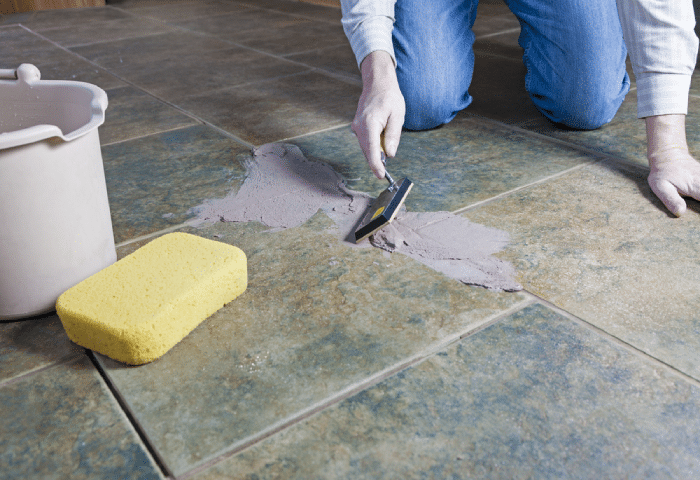We've independently reviewed this article to make sure it's as accurate as we can make it.
To find out more about our article creation and review process, check out our editorial guidelines.
Installing a new shower tile?
With an endless selection of colors, patterns, and sizes to choose from, new tiling is a fun home improvement project. One that can elevate your shower experience and give your bathroom the transformation it deserves.
But when deciding between the different types of grout to use, things can get a little tricky…
Hot water, steam, and condensation are just some of the factors you need to consider when grouting a new shower. And if you don’t install the right type of grout, it can cause inconvenient and expensive problems with your shower down the line.
So, which type of grout is best for your shower?
In general, epoxy grout is the best option for a shower. Epoxy grout has a fantastic level of water resistance and adhesive enough to bond strongly to tiles. Epoxy grout is also great for a shower as it’s highly stain resistant and easy to clean.
That said, there are many alternatives out there. There’s no one superior kind of grout, and in the following article, we’ll help you understand the different types of grout and help you choose the perfect one for your unique bathroom.
Ready? Let’s get started!
Grout Basics
What is grout, and what exactly is it made of? We must answer the question before diving into finding the best shower grout.
Grout is a reinforcing filler material that embeds, binds, and seals the space between the joints of tiles. Water, cement, and sand are the basic elements of grout ‒ but not all types of grout contain sand.

Whether your new tile shower is more for utility or show, one thing is certain: The type of grout you install needs to waterproof your shower adequately.
Otherwise, you’ll most likely find yourself having to repair things like cracked or crumbling tiles, water leaks, and other issues.
(Should you ever have to repair a leaking shower and want to avoid removing the tiles, we recommend reading our article on the topic).
When deciding between the best types of grout for a shower, there will be two rounds of decisions:
- First, decide between sanded vs. unsanded grout.
- Secondly, decide between epoxy grout vs. cement grout.
- Third, determine what color grout to use.
Consider the information above now that you know what the best grout for a shower is to make the right decision.
The Best Grouts for Shower
While many options are available when installing your shower grout, some materials are better than others. Here are some useful comparisons to help you pick the best shower grout for your bathroom.

#1 Sanded Grout vs. Unsanded Grout
Sanded grout contains aggregate sand material, while unsanded grout does not. But why does grout contain sand in the first place?
Sanded Grout
Sand provides anti-shrinkage qualities during the curing phase. As sanded grout dries, the immobile sand particles stay locked in place.
Because of its firm and rigid nature, sanded grout is also highly resistant to cracking, which makes it an ideal choice for the bathroom floor.
I don’t recommend sanded grout for filling joints that are less than ⅛-inch, which is usually the case with shower tiles – though there are exceptions. Filling such narrow joints requires higher precision, and sand particles are typically too large for smaller spaces.
Due to its high concentration of sand particles, sanded grout can also scratch softer tiling materials, such as limestone, granite, and marble.
Unsanded Grout
Without the presence of sand, unsanded grout is known to shrink because it will hold more water due to its fine texture.
As a result, there’s more water displacing the grout until the water evaporates. Since there’s more water to evaporate, the material left in the grout line appears to have shrunk more because it contained more water by volume to begin with.
Despite its shrinking qualities, unsanded grout is the most common choice for shower tiles and makes for great shower grout. Because it doesn’t contain sand, unsanded grout has a stickier consistency, making it a better and more adhesive choice for filling vertical, tighter gaps and preventing the fall of tiles.
Unsanded grout may shrink, but in my opinion, it isn’t a huge issue when dealing with vertical shower tiles bound closer together and requiring a more precise finish. Unsanded grout is also a safer option for softer stones, such as marble and limestone, because it doesn’t contain scratchy sand particles.
Sanded vs. Unsanded Grout: Which Is Better?
Generally speaking, unsanded grout should suffice in between most shower tile joints, whether or not the joints or larger or smaller than ⅛-inch wide.
If the shower tile joints are further apart and greater than ⅛ of an inch, it doesn’t necessarily mean you need to use sanded grout. Because shower tiles are vertical, you won’t need to worry so much about the tiles cracking due to pressure and weight.
(Again, sanded grout is ideal for floor tiles that absorb a lot of foot traffic.)
Should you decide to use sanded grout to fill a tighter and narrower joint, my usual advice is to mix in more water to make the grout easier to spread – but don’t do this beyond the directions on the bag.
Using excess water in sanded grout can lead to pinholes, which can trap water and potentially cause your shower tiles to collapse over time.
Remember to always finish the job with a grout sealer – especially when working with sanded grout. Otherwise, you’ll spend the rest of your natural life trying to clean the grout!
#2 Epoxy Grout vs. Cement Grout
Now that we’ve explored the differences between sanded vs. unsanded grout, let’s dive into another one of the best shower grouts – epoxy grout vs. cement grout.
Epoxy Grout for the Win! Here’s Why:
Epoxy grout is a popular choice for shower grout due to its high water resistance. Made from resin and fillers, epoxy grout is also highly adhesive as a sealant and bonds well to tiles and other building products.
Epoxy’s durability and adhesiveness make it an ideal choice in humid climates or places with high moisture and dampness, such as gym showers and indoor swimming pools.
Epoxy’s high stain resistance also makes it an ideal choice for showers. Epoxy grout requires no sealing, so it’s less maintenance-dependent. However, epoxy grout can be difficult to install because the working time is quite short – so it’s usually applied similarly to stucco, requiring additional coats.
Cement grout, on the other hand, is highly porous and more likely to shrink, crack, or break down over time. Cement-based grout is also more likely to become a breeding ground for mold and fungi due to its highly absorbent nature.
(Did you know mold can show up around a shower within 24 hours? Nothing could be worse than taking the time to install cement grout, shower, and have mold show up shortly after.)
Compared to other types of grout, epoxy is one of the more expensive materials; however, epoxy’s durability and longevity can make it a more cost-effective option, requiring fewer repairs and less maintenance over time.
How to Install Epoxy Grout in a Shower
Your epoxy grout will come with a set of directions, which can vary from product to product. But first, clean the shower thoroughly, especially the tiling. Debris and traces of dirt left behind can get caught in the grout and become hard to remove.

Using a trowel, fill the gaps in between the tiling and apply small sections of the epoxy. Smooth the epoxy out using the trowel.
I recommend having a damp sponge handy so you can clean away any epoxy residue from the towels.
As a friendly reminder, always pre-grout: You’ll use grout to fill the joints between tiles and caulk to fill the area between the tiles and the tub or shower floor. The caulk you use should also be waterproof, and a color-matched grout or caulk is always worth looking for.
# How to Choose the Right Grout Color
More often than not, unsanded epoxy grout is the best grout for showers – at least for residential purposes.
I’m not saying you can’t or shouldn’t use sanded or cement grout, but the material is more suitable when installing floors or closing large gaps (greater than ⅛ inch) between tile joints.
Choosing the color of your grout is the next step, and it’s an important one. The color of your grout can significantly affect the final result of your new tiled shower. If the color is too busy or contrasts with the tile, it can be an eyesore and make your bathroom appear small and claustrophobic.
So, how do you go about choosing the right grout color? Here are some suggestions.
Match the Tile & Grout Color
It sounds simple enough, but by matching the grout color to the tile color, you’ll create a cohesive and more spacious finish, all while drawing attention to other areas, like the bathroom mirror, the sink fixture, the linens, or the wall décor.

Choosing a white tile? Go with white grout.
Beige tile? Beige grout!
Black tile… black grout… And so on…
Complement the Grout to the Tile
If the above suggestion is too matchy-matchy, go for a grout that subtly compliments your tile color.
You can highlight your new shower tiling by using a grout of a similar shade. For example, use a soft gray grout if you’re installing white tile. The soft gray is subtle enough to create the contrast you want without drawing too much attention away from the tile.
If you’re trying to highlight a dark-colored or black tile, use a dark and shadowy grout for a contrast that’s faint enough to make the distinction but not overpower the overall finish.
Contrast the Grout & Tile
Depending on your personal taste and intention for your bathroom, contrasting the colors of your grout and shower tile can deliver bold, vivid, and head-turning results!
While contrasting colors can make your tiling appear smaller than it really is, it may be the look you’re going for, especially if the shower is fairly large and you want to “tighten” the space.
Using An Uncoupling Membrane
Whichever shower grout you use, an uncoupling membrane can be a great help in preventing cracking grout.
An uncoupling membrane provides waterproofing vapor management and load distribution to help ensure that your tiles aren’t getting any unbalanced stress or loads on them.
Choosing the Best Types of Grout for Your Shower
You work hard to make your home entirely yours, and there’s nothing more gratifying than feeling glorious in a shower you’re proud of and look forward to experiencing at the beginning or end of each day.
While there are several different types of grout out there, unsanded epoxy grout is usually the first choice for shower grouts. I hope your new shower tile installation project goes off without a hitch!
I’d love to hear all about your experience and which grout worked best for your shower! If this article proved useful, check out our other resources and free guides below and consider subscribing to our newsletter.
Happy projects!
-Craig.







